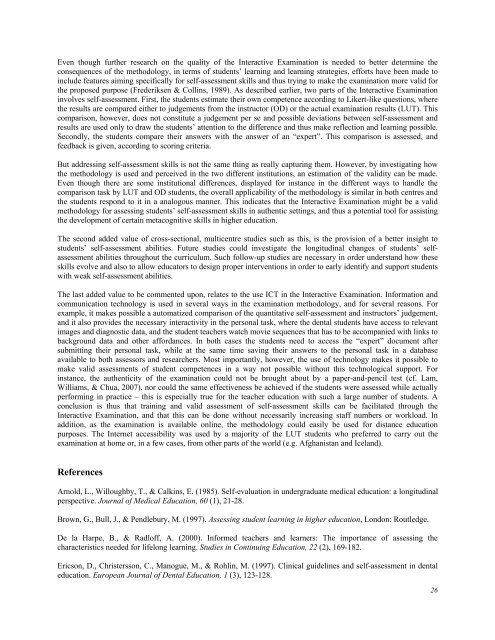October 2007 Volume 10 Number 4 - Educational Technology ...
October 2007 Volume 10 Number 4 - Educational Technology ...
October 2007 Volume 10 Number 4 - Educational Technology ...
Create successful ePaper yourself
Turn your PDF publications into a flip-book with our unique Google optimized e-Paper software.
Even though further research on the quality of the Interactive Examination is needed to better determine the<br />
consequences of the methodology, in terms of students’ learning and learning strategies, efforts have been made to<br />
include features aiming specifically for self-assessment skills and thus trying to make the examination more valid for<br />
the proposed purpose (Frederiksen & Collins, 1989). As described earlier, two parts of the Interactive Examination<br />
involves self-assessment. First, the students estimate their own competence according to Likert-like questions, where<br />
the results are compared either to judgements from the instructor (OD) or the actual examination results (LUT). This<br />
comparison, however, does not constitute a judgement per se and possible deviations between self-assessment and<br />
results are used only to draw the students’ attention to the difference and thus make reflection and learning possible.<br />
Secondly, the students compare their answers with the answer of an “expert”. This comparison is assessed, and<br />
feedback is given, according to scoring criteria.<br />
But addressing self-assessment skills is not the same thing as really capturing them. However, by investigating how<br />
the methodology is used and perceived in the two different institutions, an estimation of the validity can be made.<br />
Even though there are some institutional differences, displayed for instance in the different ways to handle the<br />
comparison task by LUT and OD students, the overall applicability of the methodology is similar in both centres and<br />
the students respond to it in a analogous manner. This indicates that the Interactive Examination might be a valid<br />
methodology for assessing students’ self-assessment skills in authentic settings, and thus a potential tool for assisting<br />
the development of certain metacognitive skills in higher education.<br />
The second added value of cross-sectional, multicentre studies such as this, is the provision of a better insight to<br />
students’ self-assessment abilities. Future studies could investigate the longitudinal changes of students’ selfassessment<br />
abilities throughout the curriculum. Such follow-up studies are necessary in order understand how these<br />
skills evolve and also to allow educators to design proper interventions in order to early identify and support students<br />
with weak self-assessment abilities.<br />
The last added value to be commented upon, relates to the use ICT in the Interactive Examination. Information and<br />
communication technology is used in several ways in the examination methodology, and for several reasons. For<br />
example, it makes possible a automatized comparison of the quantitative self-assessment and instructors’ judgement,<br />
and it also provides the necessary interactivity in the personal task, where the dental students have access to relevant<br />
images and diagnostic data, and the student teachers watch movie sequences that has to be accompanied with links to<br />
background data and other affordances. In both cases the students need to access the “expert” document after<br />
submitting their personal task, while at the same time saving their answers to the personal task in a database<br />
available to both assessors and researchers. Most importantly, however, the use of technology makes it possible to<br />
make valid assessments of student competences in a way not possible without this technological support. For<br />
instance, the authenticity of the examination could not be brought about by a paper-and-pencil test (cf. Lam,<br />
Williams, & Chua, <strong>2007</strong>), nor could the same effectiveness be achieved if the students were assessed while actually<br />
performing in practice – this is especially true for the teacher education with such a large number of students. A<br />
conclusion is thus that training and valid assessment of self-assessment skills can be facilitated through the<br />
Interactive Examination, and that this can be done without necessarily increasing staff numbers or workload. In<br />
addition, as the examination is available online, the methodology could easily be used for distance education<br />
purposes. The Internet accessibility was used by a majority of the LUT students who preferred to carry out the<br />
examination at home or, in a few cases, from other parts of the world (e.g. Afghanistan and Iceland).<br />
References<br />
Arnold, L., Willoughby, T., & Calkins, E. (1985). Self-evaluation in undergraduate medical education: a longitudinal<br />
perspective. Journal of Medical Education, 60 (1), 21-28.<br />
Brown, G., Bull, J., & Pendlebury, M. (1997). Assessing student learning in higher education, London: Routledge.<br />
De la Harpe, B., & Radloff, A. (2000). Informed teachers and learners: The importance of assessing the<br />
characteristics needed for lifelong learning. Studies in Continuing Education, 22 (2), 169-182.<br />
Ericson, D., Christersson, C., Manogue, M., & Rohlin, M. (1997). Clinical guidelines and self-assessment in dental<br />
education. European Journal of Dental Education, 1 (3), 123-128.<br />
26

















